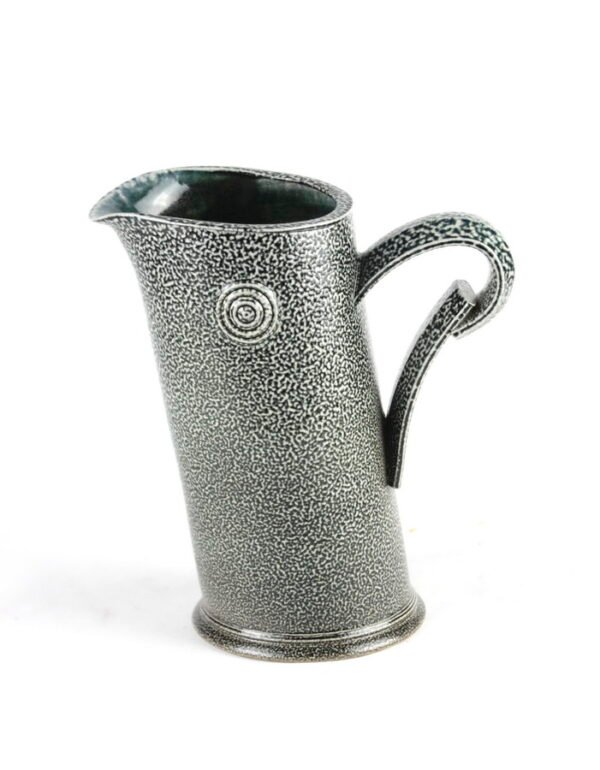ceramics
Showing 277–288 of 289 results
-

Warren Kevin
Born in 1949 in Gravesend, Kent, Kevin took up pottery at the age of 23, studying ‘Studio Pottery’ on a vocational course at Medway College of Art and Design, which he successfully completed in 1977. Following this he trained for 4 years with studio potter Mike Goddard and finally set up his own workshop in Canterbury in 1982, producing ash glazed stoneware, a range of terracotta garden pots and some decorated slipware. Kevin’s garden pot sales increased dramatically over the years and after two more workshops in Kent moved to Norfolk, continuing to make garden pots, but feeling that a new direction was needed.
-

Wearing Paul
Paul studied ceramics to postgraduate level in Cardiff where he has lived and worked since. After completing the BA course in 2000 Paul co-founded Elements Studio and Gallery where he remained for three years as Co-Director before returning to university.
Within his first year of professional practice Paul was awarded a Setting Up Grant from the Arts Council of Wales enabling him to develop a body of work and achieve his first solo exhibition ‘Beyond the Surface’ at Oriel Lliw, Pontardawe Arts Centre in 2001. He subsequently exhibited across the UK as well as internationally and in 2002 was awarded Welsh Artist of the Year for the Crafts/Applied Arts category and as a consequence achieved a further solo exhibition in 2003, ‘ A Sense of Order’ at The Model House, Llantrisant.
After the completion of his MA in 2004 Paul took time out of exhibiting to reflect on the experience and carry out further research. In 2007 he attained a space at Fireworks Clay Studios where he held the positions of Chair and Co-Director from 2008 until 2013. In 2016 Paul returned to the role of Co-Director.
In 2011 Paul was invited to co-select makers for the Elizabeth Wait Purchase Prize exhibition ‘It’s what’s on the outside that matters’ at the Newport Museum and Art Gallery and in 2014 he was invited to select for the Axisweb MA Stars Programme.
Paul received further Arts Council of Wales funding in 2014, 2017 and 2019 (see Material Matters page) supporting the development of his practice via research and studio time and widening its audience via his participation in key ceramics and craft fairs and exhibitions. In 2016 Paul was awarded Selected Membership of the Craft Potters Association and in 2018 was elected to their Governing Council.
-
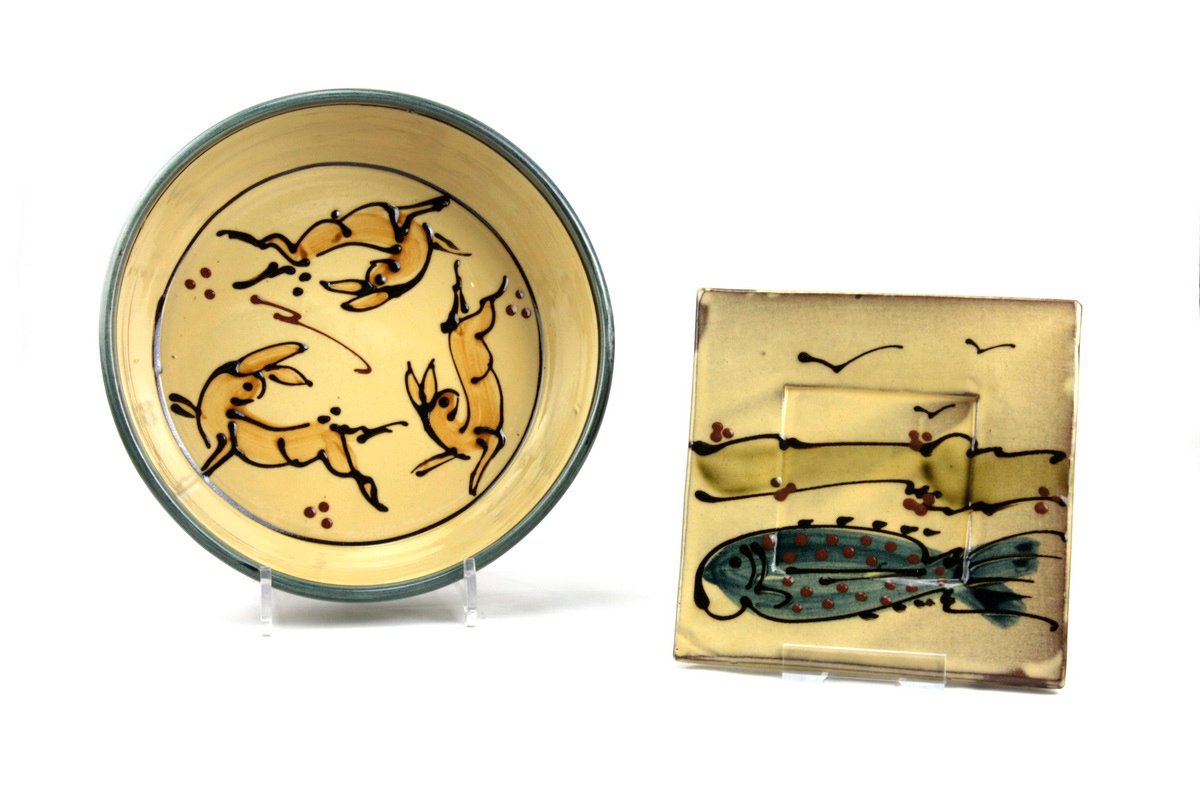
Hoogland Niek
Born and raised in a town that owed its name and existence to the clay that is dug there.
Red clay, sediment of the rivers Maas and Rhine.
Red clay, for bricks, pipes and roof tiles.
But also for the Tegelen earthenware that was famous far beyond the country’s borders.
Earthenware from Tegelen, red clay, covered with a white slip. After drying, the unfired clay is painted with coloured slips. Painting is done with brushes and slip trailers. Sgraffitto techniques are also used to scratch away the covering slip so the underlying clay can be seen.
After painting, the work is bisque-fired to 900 °C.
When the kiln has cooled down the work can be glazed and will be fired a second time to 1100 °C.
It is then that the work gets its final colour and gloss.
The work has a strong regional character. The way of working and the technique are closely related to the Nieder Rhine earthenware tradition. Motives are from the surrounding area, the river Maas being a constant source of inspiration.
Supported by this tradition “I am making contemporary ceramics, be it either one-offs, utilitarian ware made in small series or commemorative dishes for special occasions.”
-
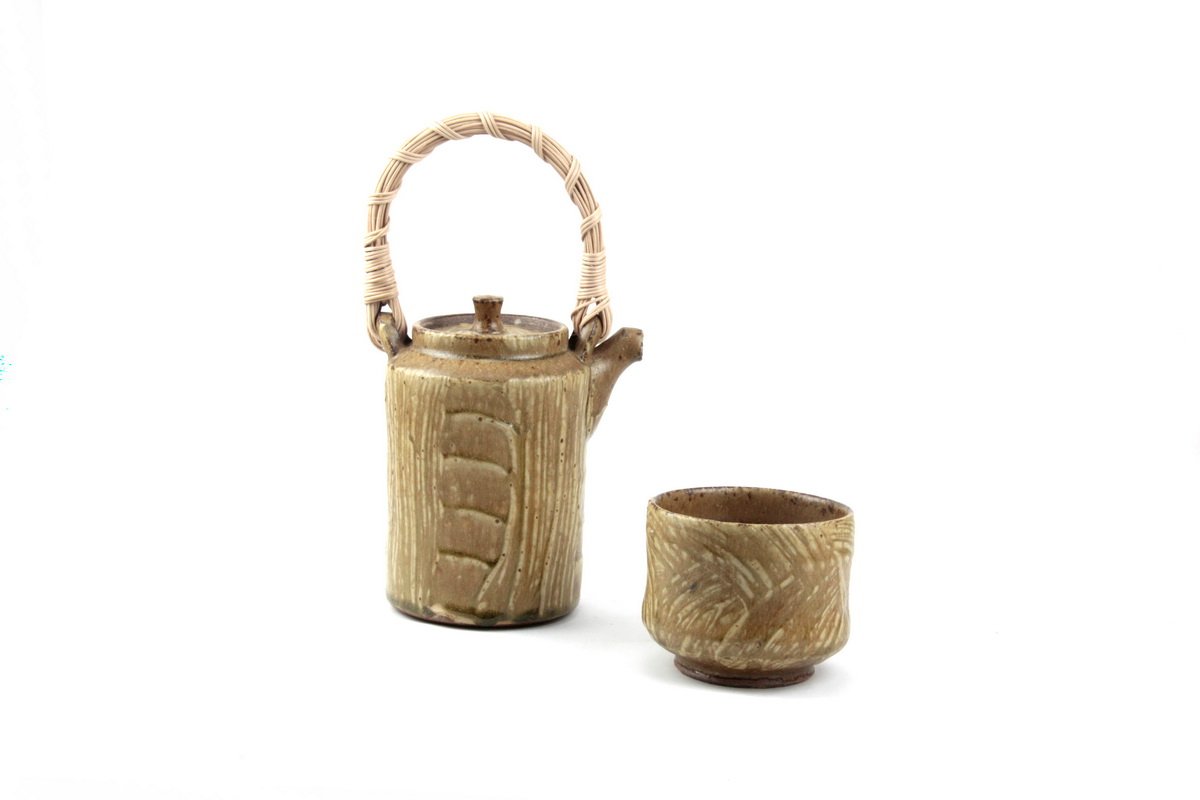
Wheeler Kat
Kat Wheeler studied ceramics at the Appalachian Center for Crafts in Smithville, Tennessee. She completed a semester study abroad at the Australia National University in 2007, before earning her B.F.A. in Ceramics in 2008. While studying, Kat worked part time for established studio potters Judy Brater and Peter Rose. Peter became a significant mentor to Kat, encouraging her to pursue opportunities to travel and work. She learned valuable studio practice and production techniques while maintaining the workshop and helping fire Peter’s two chambered wood kiln.
Kat moved to St Ives to work at the Leach Pottery in 2009, where she currently holds the position of Deputy Studio Manager. In 2015, Kat went to Mashiko and did a 10 week residency at the Hamada Workshop. Her experimentations with Hakeme brush decorations in Mashiko became a catalyst for her recent work here in St Ives.
In 2019, Kat left the Leach Studio to focus on her own pots at her workshop in the Gaolyard Studios, St Ives.
Working production in such an intensive environment as the Leach Pottery and being surrounded and encouraged by the enthusiasm of our talented workshop team has had a profound impact on me and my work. I enjoy the repetition of throwing simple forms and using contrasting slips to create texture and individuality to my range of pots.
-

Fichot Alain
Born 1952, works in Anost, France
I started out in the 1970s, working initially in wood-fired stoneware, then gas-fired. With the growing interest in glazes I turned towards porcelain. For the last 15 years I have devoted myself to objects whose function is inessential, allowing me to pay special attention to crystalline glazing – or real ‘dream skin’.
Technique
In Europe, the history of the crystal glaze begins at the 19th century in Sèvres, France, followed by the Royal Porcelain Manufacture of Copenhagen and the famous Meissen Manufacture in Germany.
Contrary to popular belief, crystals are not put into the glaze! The crystals actually start forming in the glaze during the chemical reaction while cooling and grow from small nuclei, which form during the melting process when silica and zinc come together to form zinc silicate. My work is covered with homemade zinc, frit and titanium based glaze and fired up to 2300˚ F. The temperature is then lowered to 2050˚ F so that the crystals develop. The temperature may then be stabilised around 1830˚ F to achieve the rings around the crystal nucleus. In order to vary colours, I apply a reduction atmosphere somewhere between 1900 and 1300˚ F that matches the colouring oxide used. This also gives a ‘pearly’ look to the surface.
However fascinating the technical aspects, I should hope that the viewer concentrates on the kind of ‘poetry’ that I am trying to accomplish in each piece and can share the enjoyment that I derive from the finished piece.
-
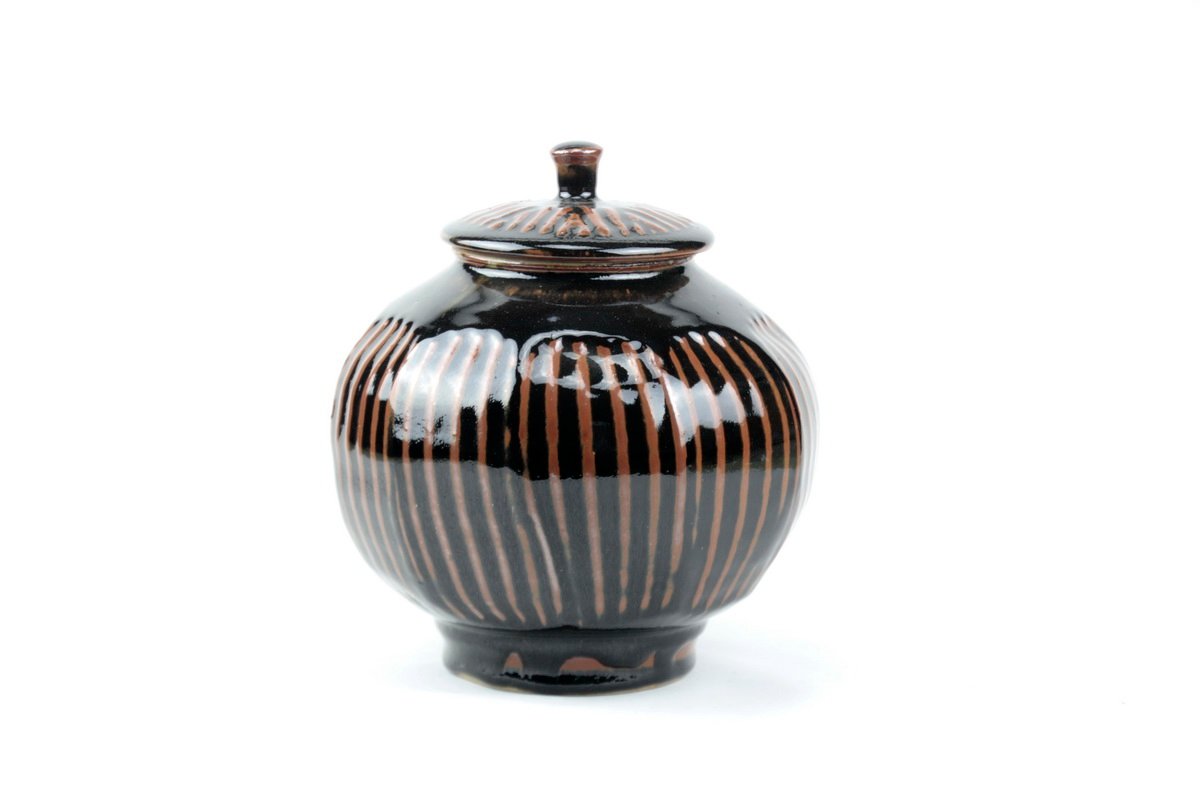
Harrison Nic
Born 1949, works in Helston, Cornwall
1975-79 Full-time mature student in studio pottery at Cornwall College
1979-81 Employed at the Leach Pottery, St Ives
1981 Established own pottery with wife Jackie.
Collections
Nic has work in private collections in London, USA, Australia, Germany, Japan, Switzerland, and Avon Schools Art & Design Loan Service, Bristol.
Awards
The Radcliffe Trust Craft Award.
Background
Nic Harrison moved to Cornwall with his wife, Jackie, in 1975. Following his studies in studio pottery at Cornwall College from 1975 to 1979, he worked at the Leach Pottery in St Ives with Janet Leach, Trevor Corser and Jason Wason.
In 1981 Nic and Jackie, a weaver, set up their own pottery and weaving workshop with showroom at Trelowarren, the historic home of the Vyvyan family near Helston. Nic produces an extensive range of kitchen, domestic, oven-to-table stoneware pottery, all hand-thrown, selling direct to the public and through local galleries. Much of his work is in the locally produced stoneware clay, although he also uses porcelain clay.
Decoration is kept simple, using cobalt, iron, copper and manganese oxides. The glazes used are a sage green celadon and a black to rust tenmoku. He prefers to leave his forms uncluttered by decoration, but when oxides are used, the ‘indefinite line’ is achieved by decorating on the surface of the glaze and is characteristic of his work.
-

Dunstan Sarah
Inspirations
I collect images, such as the shape of the railing in a hidden doorway in St.Ives, or writing on an antique glass bottle. I use my sketchbook to draw and paint these impressions but also as a scrapbook. Feathers, fabric and packaging are glued in next to photos. These photos are fragmented memories of places I’ve visited, a close-up detail of a Greek sign perhaps, or advertising on a French café wall.
I decorate a rolled out sheet of clay by using various techniques including painting and printing with coloured slips. The pieces are then put together using paper templates to create the final form, similar to the patterns that my mother used as a dressmaker when I was a child. I am fascinated by collections of objects, from the very small and personal – scent bottles, the mundane, sardine tins – to large architectural forms such as Gaudi buildings.
Some final pieces are purely ornamental while others tell a story.
Training
- Falmouth School of Art & Design BTEC Diploma: General Art and Design, Distinction, 1987-1989
- Cardiff Institute of Higher Education B.A. (Hons) in 3D Design Ceramics,
1989-1992.
Artist statement
First of all, images and ideas are collected in sketchbooks. Then, with the clay rolled out in front of me, I start to play. I might begin with a block of colour then introduce an area of decoration that moves across the surface breaking out of one area and travelling around what will become a three-dimensional piece. Like a painter, I work over the surface until it appears to be ‘right’. When the work is constructed I get a surprise, hopefully a good one, and the composition that felt right as a flat plane does something new when it becomes a vessel.
-

Gibbs Russell
Works in Cheddar, Somerset
Russell Gibbs, whose workshop was located on The Lizard Peninsular in Cornwall, has recently relocated to Somerset where he is in the process of setting up a new workshop. Maker of fine earthenware ceramics and British studio pottery, Russell’s work boasts both tradition in material and design as well as an archive of studio and statement pieces.
Originally from the far north of England, Russell studied pottery at Carlisle School of Art with Jim Malone, who greatly influenced the development of what Russell calls his ‘more spiritual work’. He is probably best known for producing a range of simply decorated earthenware pottery in his version of the Cornish Ware tradition.
-

Shimwell Alex
Alex Shimwell makes wheel thrown, functional and decorative ware at his studio in Matlock, Derbyshire. From refined, gas fired porcelain reflecting the precision of industrial production, to expressive wood fired pieces more acutely related to the freedoms celebrated in the Japanese aesthetic, his work displays the energy and attributes of the materials and processes utilised to create balanced, honest pots.
Whilst studying ceramic design at Staffordshire University, he also travelled to Japan, spending time with Numaguchi-
San, a 7th generation Jomo ware potter, learning traditional techniques and researching the aesthetic ideas that informed traditional British studio ceramics. Alex also worked under the guidance of master potter Kevin Millward learning traditional, industrial throwing techniques.
-
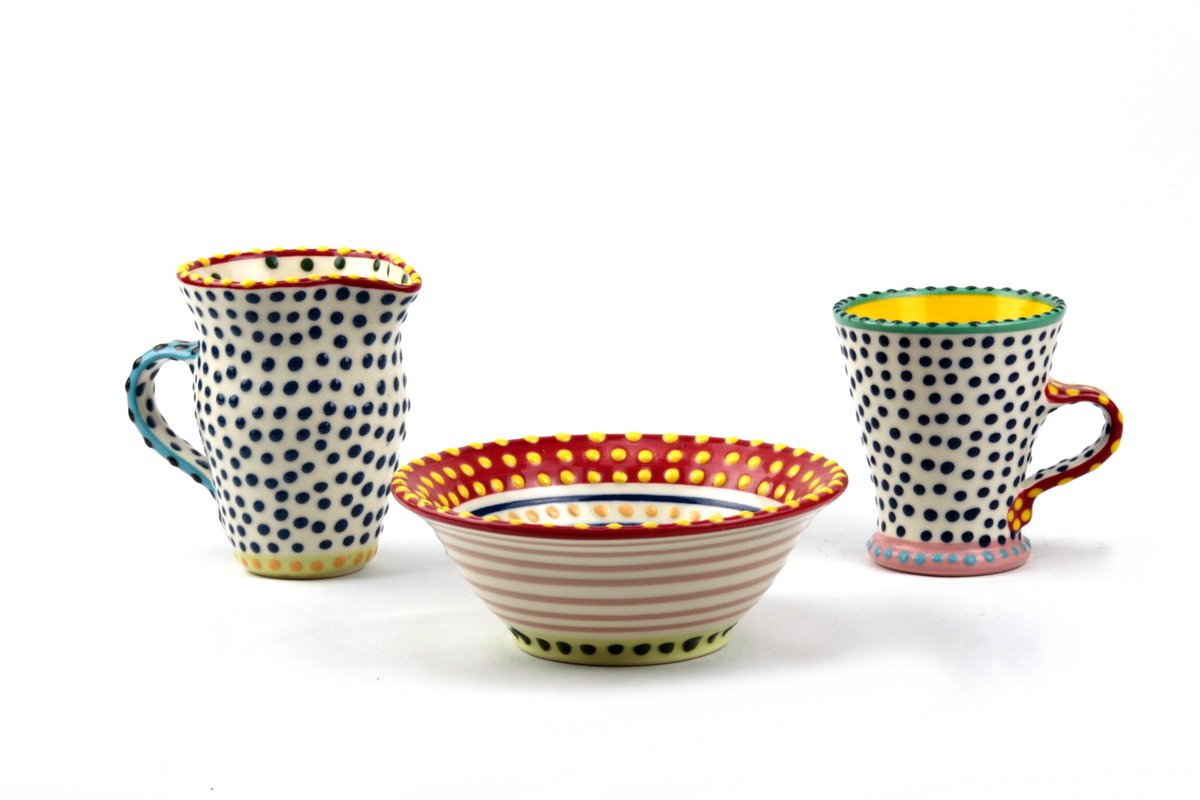
Bell Lincoln Kirby
Born: 1962, Kingston, South Australia
Lincoln’s ceramics almost entirely revolve around the concept of vessels or objects that are used for eating and drinking purposes. The work is very distinctive due to a technique that gives a raised/ textured surface to the decoration. Exuberant use of colour and bold black and white surface design adds to the overall effect. Aesthetic elements are as important as the functional considerations, the two coming together to create a uniquely individual object.
“The roots of my decorating techniques” says Lincoln “lie in the 16th and 17th Century slip-trailed wares of English folk potters, such as those produced by the Toff and Simpson families in England before the advent of the Industrial Revolution.
“My decoration is largely inspired by basic design elements that can be found in all ancient civilizations – spots, spirals, circles, linear patterns and stripes. Whether it is just pattern or imbued with meaning is another story! I still find it very magical and grounding that the elements of earth, water, air and fire are all involved in the making of ceramics.”
Since completing a degree in ceramic design in 1983 Lincoln has worked full time as a studio potter in a number of countries. He has also carried out some teaching and worked on a number of archaeological excavations with a ceramic component.
He set up his Newlyn studio in 2008, from where he continues throwing and hand building an array of slip-trailed tableware and sculptural pieces.
-
Huisseling Pim Van
Biography
Initially trained as a nurse, then worked with mentally disabled people for several years.
1978-1983 Extensive international travel including Afghanistan, India, Spain and Israel
1991 Set up a pottery studio with partner Niek Hoogland at Grotestraat 52 in Tegelen
1993 Set up larger studio at Bongerdstraat 26A in Tegelen
1997 We move the studio, shop and family to Parkstraat 11B in Steyl
1999 Work full time in pottery and begin personal body of work.
Training
1991 Studio experience with partner Niek Hoogland
2002-2006 Pottery training with Joop Crompvoets, Pottenbakkerij de Walsberg in Swalmen.
Work in public collections
- Rufford Ceramic Centre, Ollerton, Notts, UK
- El Museo Nacional de ceramica y Artes Suntuarias ‘Gonzales Marti’, Valencia
- Collection Adolf Egner, Valencia, Spain.
In 1991 Niek Hoogland and I set up our pottery Pottenbakkerij Hoogland in Tegelen. We are both makers of ‘slipware’ ceramics. We like to make pots for daily use. We also make more free work for exhibitions and commissioned work. Since 1997 we live and work a stone’s throw from the river Maas in the monastic village of Steyl near Venlo.
All our work is made from a red-firing earthenware clay, a mixture of locally dug clay and sand and an earthenware clay from the Westerwald. Most of the work we produce is made on the potters’ wheel or slab built. Decoration is done with coloured slips or engobes. We use a wide variety of brushes and slip trailers to decorate our work. More subtle decorations are scratched through the white slip to reveal the underlying red clay, a technique that is called sgraffito. After decorating, the work is raw glazed with a transparent glaze and fired to 1,100 degrees centrigrade in either a gas or an electric kiln. Slipware ceramics originate in the Byzantine and early Islamic Middle-East and the technique spread all over Europe in the Middle Ages. Tegelen and Steyl are geographically part of the Nieder-Rhein or Lower-Rhein region, an area that from the 17th Century developed into a centre for slipware ceramics – a tradition that lasts to this day. Although we don’t feel inheritors of this centuries old tradition, we do feel it as an important source and starting point from which we want to develop our work as contemporary potters.
Source: http://niekhoogland.nl/ and https://mungyeongint.wordpress.com/netherlands-pim-van-huisseling/
-
Salt glazed jug ht. 19 cm
£850.00For shipping outside the UK please contact the gallery for details.

